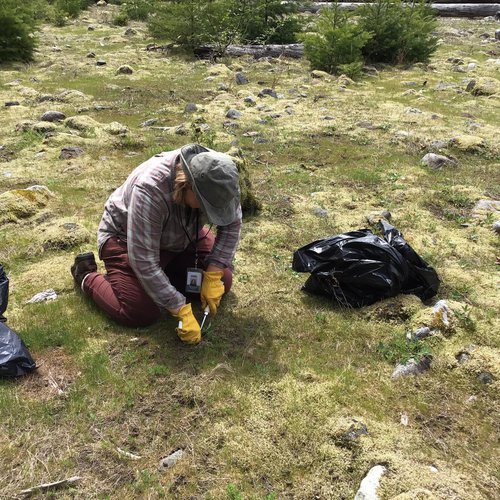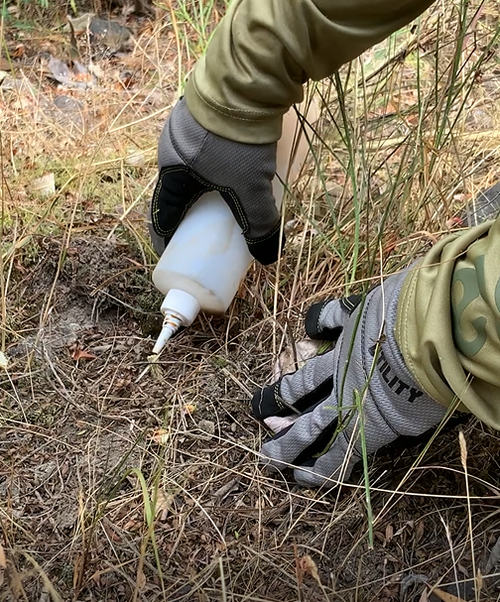Fall Weed Control Tips
LCNWC article for the Fall 2022 issue of WA's Forest Stewardship Notes Newsletter

Autumn is a great time to control many biennial and perennial noxious weeds! The autumn weed control window opens when the fall rains begin and it closes just before the first hard frost of winter. Many plant species utilize this time frame to translocate carbohydrates down into their root systems, in preparation for winter dormancy, which means that they are particularly vulnerable to damage and treatment efforts this time of year.
Manual control, like pulling or digging, requires less effort when done early in the rainy season. Roots cannot anchor in the moist ground as well as they can in dry compact soils. Many of the biennial weeds, such as tansy ragwort, start their life cycle in the fall, so hand-pulling the young plant, or "rosette", now will save you time and trouble in the summer. When tackling tenacious perennials, it is crucial that you remove as much of the root as you can. New shoots will often appear within weeks of hand-pulling the vegetative matter. Continue pulling these shoots every couple of weeks and eventually the carbohydrate reserves will be depleted and the plant will not survive.

Cultural weed control methods include basic “good housekeeping” and land maintenance chores. Apply soil amendments that favor desirable vegetation, giving them a competitive advantage against unwanted vegetation. Seeding wildflowers and grasses, and planting trees and shrubs, is best done in the fall, and will go a long way toward occupying otherwise “empty” space, where weeds would quickly fill in. Replanting native plant species is not only helpful in providing competition against weeds, but may be necessary if you are removing species that provided erosion control on slopes and hillsides. This is especially important in riparian areas! Refreshing mulches will also help in the fight against weeds.
For the really stubborn weeds, chemical control methods take advantage of the aforementioned translocation activities of many plants that are just gearing up in early fall. The weeds most suited for a fall foliar herbicide application include Canada thistle, Bull thistle, Milk thistle, Spotted knapweed, Meadow knapweed, Garlic mustard, Sulfur cinquefoil, Yellow archangel, Blackberries, and Tansy ragwort. Many of these species will be in their rosette stage and particularly susceptible to herbicides at this time. Always make sure to read the label carefully, as some herbicides are only effective during limited time frames (i.e. while the plant is in a specific stage, such as bolting or budding). Just because an herbicide was effective on a particular plant in May, does not mean it still will be in October!

Another herbicide application method, called “cut-stump,” is also appropriate for this time of year, and helps limit the amount of herbicide used while still maximizing the effectiveness of the chemicals. This method entails cutting the trunk or stem of a woody plant (such as Scotch broom, Holly, invasive Hawthorn, or Tree-of-heaven) no more than 4” from ground level and immediately applying herbicide to the wound, within two minutes or less, especially around the outer edges. The herbicide kills the stump and prevents any of the new shoots that would normally occur after cutting and minimizes any off-target damage. Sending out new suckers after being cut can make control of a large, woody plant very difficult, as the new suckers generate food for the growth of the existing root system and can utilize current reserves to grow very quickly! While this method can generally be done any time of year, it is much more comfortable to conduct cut-stump activities in cooler weather. Typically, it is only performed with triclopyr and glyphosate products. Product labels with these chemicals will have specific instructions for timing and amounts of concentrate used.
Long-term planning is a vital part of any weed control plan! It is important to note the ounce(s) per acre maximum, any grazing or haying restrictions, and any residual effects of whatever herbicide you choose. The label is the law. If you intend on using the same active ingredient for both a spring and fall application you may need to make sure you are not applying at the highest rate, so that you do not exceed any yearly maximums listed on the label.
Ideally, a well thought out weed management plan should incorporate many of the methods discussed above. Your county’s Noxious Weed Control program supports and promotes Integrated Pest Management (IPM) as the best approach for good land stewardship. Connect with your local Noxious Weed Control office to identify how best to control invasive and noxious weeds on your property, or if you have any other noxious weed-related questions. Noxious weed control requires community-wide awareness and participation across all types of landowners, please be an advocate of invasive noxious weed control in your area, and help protect Washington’s resources!
-Lewis County Noxious Weed Control
